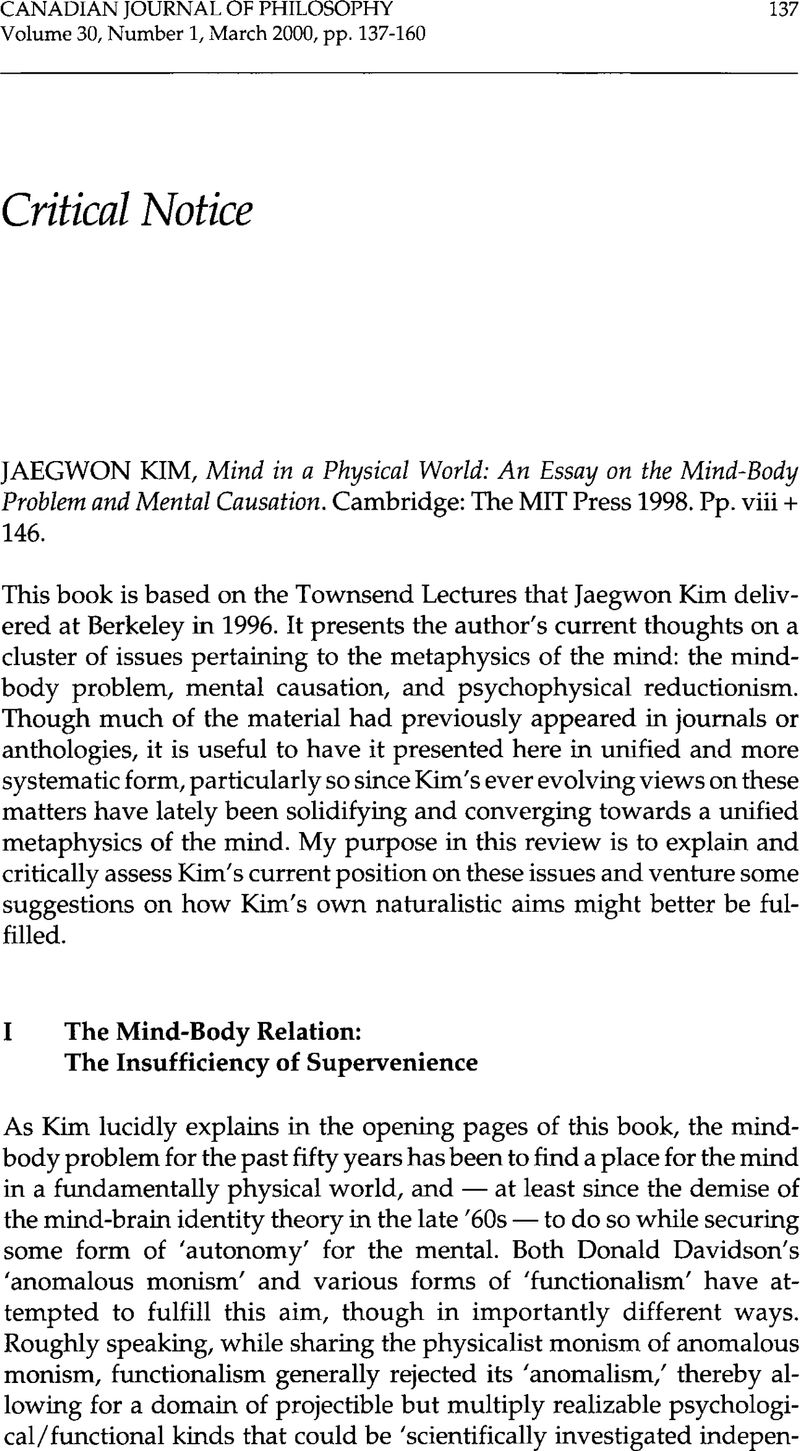Article contents
Jaegwon Kim Mind in a Physical World: An Essay on the Mind-Body Problem and Mental Causation. Cambridge: The MIT Press 1998. Pp. viii + 146.
Published online by Cambridge University Press: 01 January 2020
Abstract

- Type
- Critical Notice
- Information
- Copyright
- Copyright © The Authors 2000
References
1 Notable exceptions: David Armstrong and David Lewis, who ‘thought they were defending type physicalism’ (7, n.10).
2 To accommodate substance dualism, supervenience needs to be defined over multiple domains, so the individuals having the M properties are distinct from the individuals having the P properties. See Kim, ‘Supervenience for Multiple Domains,’ reprinted in Supervenience and Mind (Cambridge: Cambridge University Press 1993), 109-30CrossRefGoogle Scholar. But even that is not enough, as I presently explain.
3 ‘Supervenience as a Philosophical Concept,’ Metaphilosophy 21 (1990) 1-27
4 At the end of the section where the issue is raised (14-15), Kim seems to agree at least with part of this claim: thus he acknowledges that ‘mind-body supervenience is inconsistent with … Cartesian dualism’ (why then his previously quoted claim about substance dualism? ) and with certain ‘forms of dualism, e.g. Spinozistic double-aspect theory and Leibniz's doctrine of preestablished harmony’ (15, n. 22). However, he insists that supervenience is consistent with type physicalism, and so he merely concedes that supervenience ‘represents the idea that mentality is physically based’ and can thus ‘be viewed as defining minimal physicalism’ (15). But if I am right, it can be seen as excluding what we may call the ‘maximal physicalism’ represented by reductive type physicalism. I offer a sustained argument for this claim in my ‘Supervenience and Reducibility: An Odd Couple,’ Philosophical Quarterly 43 (1993) 215-22.
5 What a solution to the mental causation problem must provide is not only a way to avoid token epiphenomenalism but type epiphenomenalism as well; cf. McLaughlin, Brian ‘Type Epiphenomenalism, Type Dualism, and the Causal Priority of the Physical,’ Philosophical Perspectives 3 (1989) 109-35.CrossRefGoogle Scholar
6 Psychosemantics (Cambridge: The MIT Press 1987), 42; quoted by Kim, 40
7 Kim explicitly construes supervenience as a noncausal relation (cf. 44), and finds, e.g., John Searle's causal reading of supervenience ‘highly idiosyncratic’ (47).
8 For brevity, Kim often speaks of one property causing another property: ‘this is to be understood to mean that an instance of the first causes an instance of the second’ (41-2).
9 This type of criticism is developed in greater detail in my ‘Kim's Principle of Explanatory Exclusion,’ Australasian Journal of Philosophy 76 (1998) 439-51.
10 ‘Mental Quausation,’ Philosophical Perspectives 3 (1989) 47-76. ('Quausal’ is an abbreviation for ‘qua-causal.’)
11 For the distinction between Davidsonian events and events as property exemplifications (or tropes) see Davidson, ‘The Individuation of Events,’ reprinted in his Essays on Actions and Events (Oxford and New York: Oxford University Press 1980)Google Scholar, and Kim, ‘Events as Property Exemplifications,’ reprinted in his Supervenience and Mind (Cambridge: Cambridge University Press 1993)CrossRefGoogle Scholar.
12 That this is what Kim has in mind may be suggested by the following remark, intended to clarify the sense in which an instance of a property causes an instance of another property: ‘it must further be the case that one instance causes another instance in virtue of the fact that the first is of [sic] an F-instance and the second is a G-instance’ (42, n. 22). This ‘further’ condition would be redundant if property instances were tropes.
13 Kim, makes this distinction in ‘Can Supervenience and Non-Strict Laws Save Anomalous Monism?’ Heiland, J. Mele, A. eds., Mental Causation (Oxford: Clarendon Press 1993), 23Google Scholar.
14 1n reply to a similar point made by Searle, Kim (47f.) claims that regarding M's causing M* and P’ s causing P* as ‘descriptions of the same situation’ is plausible only if one is prepared to say that M = P and M* = P*, and indicates that he would regard this as a viable strategy. But the terms of the causal relation Kim has in mind here are property instances in the sense of tropes (which are individuated by their constitutive properties), not in the sense of Davidsonian events. The causal exclusion problem would thus be avoided only at the cost of accepting reductive, type-type psychophysical identities. Which is, as we shall see, the route Kim chooses to follow.
15 It's unclear why disjunctive facts should be less problematic than disjunctive properties. I take it Kim means that the fact that something has M amounts to the fact that it has P1 or to the fact that it has P2.
16 ‘Psychophysical Supervenience and Nonreductive Materialism; 290
17 Cf. Cummins, Robert The Nature of Psychological Explanation (Cambridge, MA: The MIT Press 1983), ch. 2.Google Scholar
18 When scientists conjectured that smoking causes cancer, they looked for underlying mechanisms to bear out their conjecture. It would be bizarre, once the mechanisms were found, to take their existence as showing that it's not really smoking that causes cancer, but only the physical properties of the underlying mechanisms!
19 ‘Mental causation: What? Me Worry?’ Philosophical Issues 6 (1995), 128
20 I am grateful to the Social Sciences and Humanities research Council of Canada for support in this research. Some of the material in this review was presented at a symposium on mental causation held by the Southern Society for Philosophy and Psychology at New Orleans in April 1998. I benefited from comments by co-symposiasts Louise Antony, Terence Horgan, and Jaegwon Kim.
- 11
- Cited by




